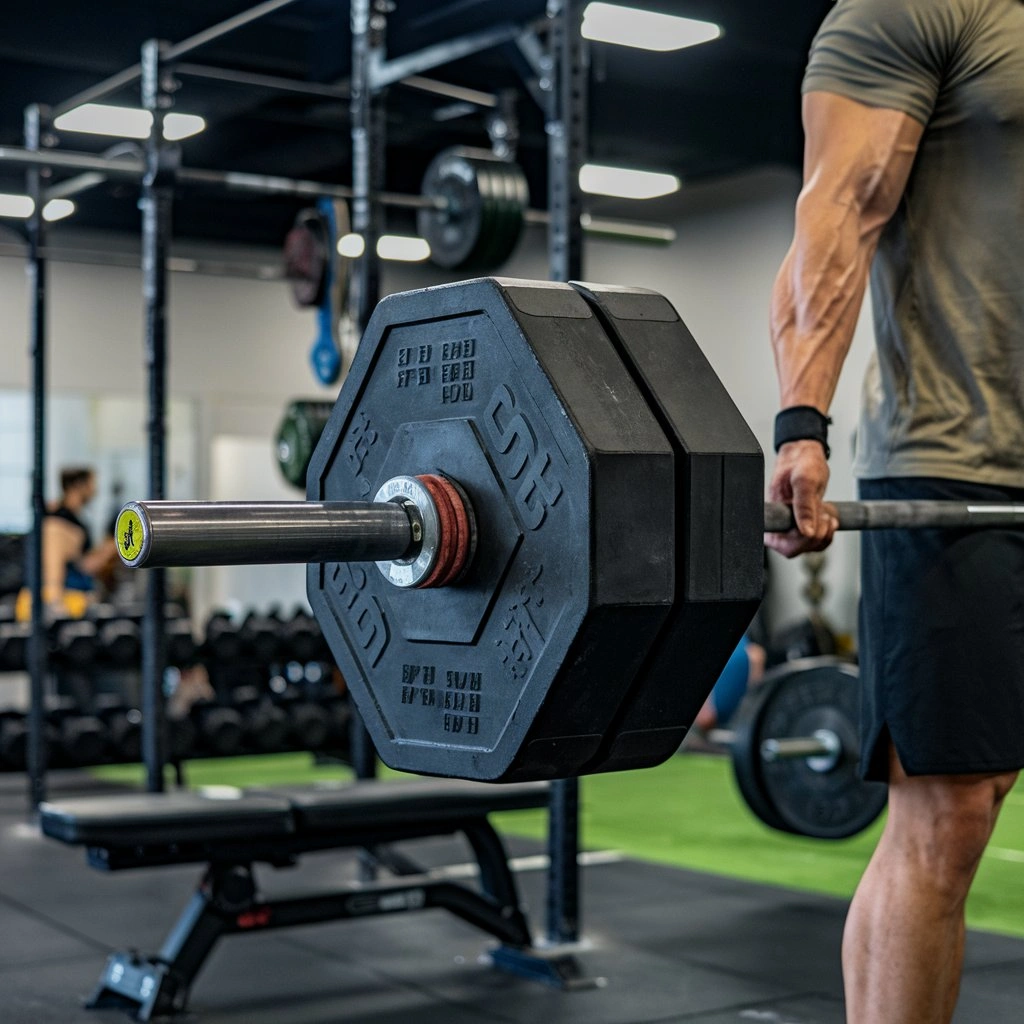Good evening, everyone, and welcome to our barbell class! I’m thrilled to see each of you here, ready to embark on this journey towards strength and fitness.
For those who might be new to barbell training, let me give you a quick rundown of what to expect. Our class will focus on utilizing barbells as a primary tool for resistance training. Throughout the session, we’ll do many exercises. They target Different Muscle groups. The goal is to boost strength, muscle tone, and fitness.
Now, why barbell training? Well, let me tell you, the benefits are many. Only, it’s an incredible way to build strength. We challenge our muscles with heavier weights. This stimulates growth and development. It leads to increased strength over time.
Additionally, barbell training is fantastic for muscle toning. We engage in compound movements like squats, deadlifts, and presses. They recruit many muscles at once. This promotes muscle definition and a toned body.
And let’s not forget about the total fitness improvements. Barbell exercises need stability, coordination, and proper form. They boost our abilities and our posture, balance, and movement.
So, whether you’re here to get strong, get toned, or only improve your fitness, you’re in the right place. Get ready to challenge yourself. Push your limits and enjoy the rewards of Barbell Training. Let’s make every rep count!
 Warm-up (10 minutes)
Warm-up (10 minutes)
Do Arm Circles. Keep your feet shoulder-width apart. Spread your arms to the sides. Rotate your arms in small circles, increasing the size of the circles. Do this for about 30 seconds, then switch directions.
Leg Swings: For support, stand close to a wall or other large object. Swing one leg forward and backward in a controlled motion, allowing your leg to swing and run. Do 10-15 swings on each leg.
Bodyweight Squats: Stand with your feet shoulder-width apart, toes less turned out. Lower your body by bending your knees and pushing your hips back as if you’re sitting in a chair. Keep your chest up and back straight. Lower down as far as you can, then push through your heels to return to the starting position. Repeat for 10-15 reps.
Take a step forward with your right foot. Bend your body until both knees form a 90-degree angle, keeping your back knee only above the ground. Repeat on the other side after pushing yourself back up to the starting position. Do 10-15 lunges on each leg.
Do bodyweight Deadlifts. Stand with your feet shoulder-width apart. Keep your knees less bent. Rest your hands on your thighs. Keep your back flat. Hinge at your hips and lower your torso toward the ground. Slide your hands down your legs. Once you feel a stretch in your hamstrings, go back to the starting position. Repeat for 10-15 reps.
Do each movement for about 30 seconds to 1 minute. Raise the intensity as you progress through the warm-up. This routine will help activate your muscles. It will also loosen up your joints. This will prepare you for the barbell workout ahead.
Barbell Squats (15 minutes)
- Foot Placement: Stand with your feet shoulder-width apart, toes pointing less outward. This position allows for stability and proper alignment throughout the movement.
- Keep your back straight. Keep your chest up and shoulders pulled back as you move. Engage your core to maintain stability and prevent rounding of the back.
- Depth: Lower your body by bending at the hips and knees, keeping your weight on your heels. Aim to descend until your thighs are parallel to the ground or a bit lower. This ensures the proper depth to activate the leg muscles.
Now, let’s go through a series of squats with an empty barbell
- Grab the barbell with an overhand grip less wide than shoulder-width apart. Rest it on the back of your shoulders. Keep your elbows pointed down and less back.
- Inhale large, flex your abs and extend your legs to unrack the barbell.
- Step back from the rack. Stand with your feet shoulder-width apart. Point your toes less outward.
- Keep your chest up and back straight. Start the squat by bending at the hips and knees at the same time.
- Descend until your thighs are parallel to the ground or lower. Keep proper form throughout.
- Push through your heels to drive yourself back up. All extend your hips and knees as you return to the starting position.
- Repeat for the desired number of repetitions. Focus on keeping proper form and control in each one.
Now, for variations
- Front Squats: Instead of resting the barbell on your back, hold it in front of your shoulders. Keep your elbows pointed forward. This variation gives more attention to the quadriceps and core muscles.
- Goblet Squats: Hold a single dumbbell or kettlebell at chest level. Hold it with both hands and point your elbows down. Perform the squat movement while keeping the weight close to your body. This variation helps improve squat depth and reinforces proper form.
- Assisted Squats: Some need help or changes. They can use a resistance band. Loop it around a stable object or squat rack. Hold onto the band for support. Do this as you do bodyweight squats. It easily adds depth and resistance as you get stronger.
Barbell Deadlifts (15 minutes)
Setup
- Approach the barbell with your feet about hip-width apart.
- Place the barbell across the midpoint of your feet.
- Bend at your hips and knees to lower yourself down to the bar, keeping your back straight.
- Grip the barbell with your hands less wider than shoulder-width apart. Use either a double overhand grip or a mixed grip (one hand overhand, one hand underhand).
- During the workout, tighten your core muscles to maintain your body’s stability.
- Your shins should be touching the barbell.
Hip Hinge
- Start by moving your hips back. You should keep your back straight and your posture upright.
- Imagine pushing your hips back towards a wall behind you.
- Throughout the exercise, keep the barbell near to your body.
Lift Off
Once your hips are back and your back is straight, drive through your heels to lift the barbell off the ground.
- As you lift, focus on pushing the floor away from you rather than pulling the barbell up.
- Keep your arms straight throughout the lift, using them as hooks to hold onto the barbell.
Lockout
As you stand up with the barbell, squeeze your glutes at the top of the movement to extend your hips.
- Pull back your shoulders and lift your chest while keeping your spine in a neutral position.
- Avoid leaning back large at the top of the movement.
- Pause short at the top before lowering the barbell back down.
Lowering
- To lower the barbell, reverse the movement by pushing your hips back first.
- Keep your back straight as you lower the barbell back down to the ground.
- Control the descent of the barbell to maintain proper form and prevent injury.
Repeat
Do the needed reps with good form. Then, sure, put down the barbell.
Throughout the exercise, it’s important to focus on proper form. This is true even if it means using lighter weights. Easy to lift weights. Do this as you get stronger and more comfortable with the movement. Always focus on form over weight. Also, if you feel pain or discomfort during the exercise, stop right away. Check your form or ask a qualified trainer for help. That’s an important disclaimer for any exercise class. This is especially true for ones with weights, like a barbell class. Safety should always be the top priority when working out. It’s crucial to listen to your body and stop if something doesn’t feel right. Proper form is key to preventing injuries. So, ask a qualified trainer for help or clarification if needed.
 Barbell Bench Press (15 minutes)
Barbell Bench Press (15 minutes)
Setup
- Bench Placement: Position the bench in the center of the rack. Ensure it’s stable and secure.
- Bar Height: Adjust the J-hooks on the rack to a height where people can remove the bar. They should be able to place it without straining.
- Hand Placement: Tell participants to grip the bar. Their hands should be wider than shoulder-width apart. When lowering the bar, keep your wrists in line with your elbows.
- Encourage participants to make a slight arch in their lower back. They should do this by pressing their shoulders onto the bench. This lessens the chance of injury and aids in maintaining stability.
- Feet Placement: Feet should be fast planted on the ground, creating a stable base. You can bend your legs at a comfortable angle.
Bar Path
- Unpacking: Tell participants to lift the bar off the rack by straightening their arms. They should ensure it’s lead above their chest.
- Lower the Bar: Guide them to lower it toward their mid-chest. Keep their elbows at a 45-degree angle from the body. The bar should touch the fall on the chest.
- Press the Bar: Encourage participants to press the bar back up by pushing through the heels. This engages the chest, shoulders, and triceps.
- Lockout: At the top of the movement, arms should be all extended but not locked out. Maintain tension in the chest muscles.
- Do the reps with smooth, controlled motion. Focus on keeping proper form.
Regressions
- The floor press is for people who struggle with stability or range of motion. I say floor presses. Lie on the floor or a mat with knees bent and feet flat. Press the bar from the bottom position to full extension.
- This change reduces the range of motion. It also shifts the focus to the upper chest muscles.
Throughout the session, stress the importance of proper breathing. Breathe in as you descend, and out as you ascend. Keep the core engaged and avoid excessive arching of the back. Encourage participants to use a weight they can lift with good form. It should challenge them but not make them lose form.
 Barbell Rows (15 minutes)
Barbell Rows (15 minutes)
Proper Barbell Row Form
Starting Position
- Stand with feet shoulder-width apart, knees less bent.
- Hold the barbell with an overhand grip, hands less wider than shoulder-width apart.
- Hinge at the hips, keeping the back straight, chest up, and shoulders down and back.
- Arms should be all extended, perpendicular to the ground.
Execution
- Pull the barbell towards the lower chest or upper abdomen, keeping elbows close to the body.
- Squeeze the shoulder blades together at the top of the movement to engage the back muscles.
- Keep the core tight throughout the movement to maintain stability.
- Lower the barbell back down under control, maintaining the same straight-back position.
Breathing
- Inhale as you lower the barbell.
- Exhale as you pull the barbell towards your body.
Common Mistakes to Avoid
- Rounded back: Maintain a neutral spine throughout the movement to prevent injury.
- Using momentum: Focus on controlled movements rather than jerking the weight up.
- Keep the shoulders down and back. This engages the back muscles.
Variations
Bent-Over Rows
- This is the standard barbell row described above.
- It targets the upper back, lats, and biceps.
Inverted Rows
- Lie under a bar. It can be a Smith machine, TRX, or low-hanging bar. Grasp it with an overhand grip and pull your body towards the bar.
- This variation is great for beginners or those who want to focus on bodyweight strength.
- It targets similar muscles as bent-over rows but with less resistance.
Single-Arm Rows
Stand beside a bench. Put a hand and a knee on the bench. Hold the dumbbell or kettlebell with the other hand. Then, row it towards your hip.
This one-sided movement helps find and fix strength imbalances. They are between the left and right sides.
It targets the same muscles as barbell rows but with increased stabilization. It is a barbell class. It targets the same muscles as barbell rows. But, it also has more stabilization. It sounds like a great way to boost strength and coordination. By emphasizing stabilization, participants can build muscle strength.
They can also improve their balance and core stability. These are crucial for fitness and injury prevention. Adding stability-challenging exercises engages small stabilizing muscles. This promotes broader and functional strength. This approach could offer participants a well-rounded workout. It builds muscle and boosts total fitness.
Cueing
- Emphasize keeping the back straight throughout the movement.
- Encourage participants to use their core. This prevents swaying or overarching of the lower back.
- Remind them to focus on working the muscles (upper back, lats) rather than only moving the weight.
Duration
Do 3-4 sets of 8-12 reps with good form. Rest for 60-90 seconds between sets. Adjust the weight for each person’s fitness level. This helps them keep good form. In a barbell class, it’s essential to tailor the weight to each participant’s fitness level. This ensures they can keep proper form during the exercises. This custom approach cuts injury risk. It also boosts workout effectiveness. Instructors can empower them by assessing their abilities.
They can offer a range of weight options. They can help them to challenge themselves. Proper form and technique are key. Instructors provide guidance and corrections as needed. Encouraging open communication allows participants to express any concerns or limits. This helps create a supportive and inclusive space. We focus on individual needs and progression. Everyone can enjoy a barbell class. They can do so while limiting the risk of overexertion or injury.
Cool-down and Stretching (10 minutes)
Deep Breathing (1 minute): Begin by standing tall with your feet shoulder-width apart. Breathe in low through your nose. This expands your diaphragm. Breathe out through your mouth to release any tension. Let’s do this for one minute, focusing on each breath.
Neck Stretch (30 seconds on each side): Tilt your head to one side. Bring your ear towards your shoulder until you feel a stretch along your neck. Hold for 30 seconds, then switch sides. Remember not to force the stretch, only go where you feel comfortable.
Shoulder Stretch (30 seconds on each side): Bring one arm across your body. Use your other arm to kindly pull it closer until you feel a stretch in your shoulder. Hold for 30 seconds, then switch sides. Keep your shoulders relaxed throughout.
Stretch each triceps for 30 seconds. Reach one arm overhead and bend it at the elbow. Put your hand on the back of your neck. Use your other hand to kindly press on your elbow, feeling a stretch along the back of your arm. Hold for 30 seconds, then switch sides.
Forward Fold (30 seconds): Stand with your feet hip-width apart. Easy bend forward from your hips, reaching towards your toes. Let your head and neck relax, feeling a stretch in your hamstrings and lower back. Hold for 30 seconds, breathing low.
Quad Stretch (30 seconds each side). Stand tall. Bring one foot up towards your glutes. Hold your ankle with the same side hand. Keep your knees close together. Push your hips forward a bit. This will deepen the stretch in the front of your thigh. Hold for 30 seconds, then switch sides.
Calf Stretch (30 seconds on each side): Step one foot back, keeping it straight. Press the heel into the ground while bending your front knee. You should feel a stretch in your calf muscle. Hold for 30 seconds, then switch sides.
Stretch your hamstrings for 30 seconds on each side. Sit on the ground with one leg straight and the other bent. Place the foot against the inner thigh of the extended leg. Reach towards your toes, feeling a stretch in the back of your thigh. Hold for 30 seconds, then switch sides.
Final Deep Breaths (1 minute): Let’s finish with another round of deep breathing. Inhale positivity and exhale any remaining tension. Close your eyes if you feel comfortable. Focus on the relaxing feeling in your body.
Conclusion
Thank you all for attending today’s barbell class! I hope you found it challenging and rewarding. Adding barbell exercises to your fitness routine can boost your strength. They can also increase muscle growth and health. Remember to do it.
As you continue to practice barbell exercises, add these tips to your workouts.
- Focus on proper form. You must keep proper form in barbell exercises. This prevents injuries and boosts results. If you’re unsure about your form, don’t hesitate to ask for help from a certified trainer.
- Increase the weight. As you get more comfortable with barbell exercises, add weight. This keeps challenging you and growing your muscles.
- Rest and recovery are key. Let your muscles rest between barbell workouts. This prevents overtraining and promotes muscle growth.
For those looking to improve, seek extra resources. These include online tutorials, fitness apps, and personal training.
Next, I’d love to hear your feedback and suggestions for future classes. Your input is invaluable. It will help me tailor future sessions to better fit your needs and preferences.
Thank you again for joining me today, and I look forward to seeing you at the next barbell class!

